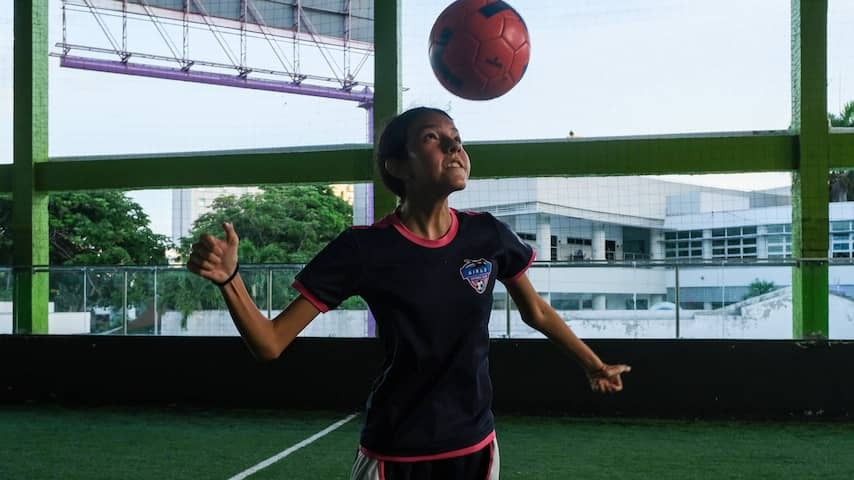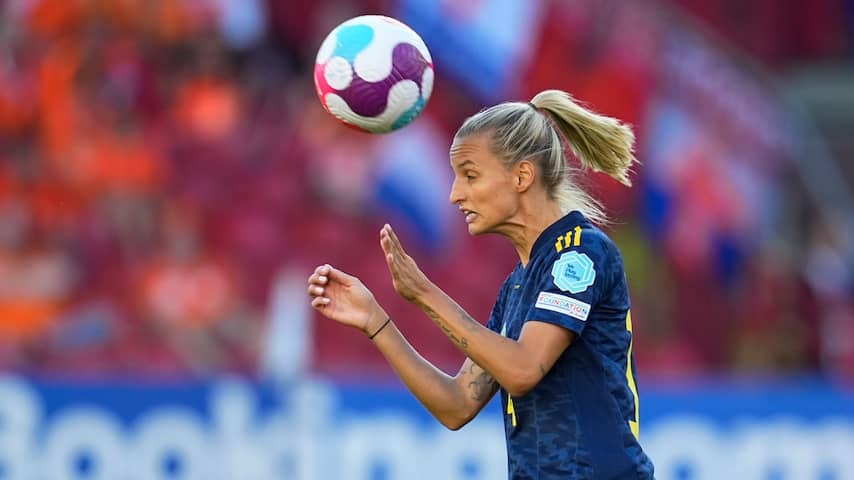
The Dutch Sports Council (NLsportsraad) wants to make football safer with the advice to prohibit headlines in children up to the age of twelve, and not change the sport. The KNVB is not planning for the time being to introduce a ban.
Tom van ‘t Hek has also seen the skeptical reactions pass by. “I have read that we want to get football,” says the chairman of NLsportraad in conversation with NU.nl. “Or that we want nobody to be allowed to head anymore and that the Orange will no longer go to the World Cup. It doesn’t annoy me, but it’s briefly through the corner.”
NLSportraad came on Wednesday morning at the request of the Ministry of Health, Science and Sport (VWS) with a strong advisory report. According to the organ, young athletes must be better protected against brain injury by preventing repeated main contact as much as possible.
The proposal to prohibit headlines in football for children up to the age of twelve, and strongly advised against athletes between twelve and eighteen, is the most striking. But according to Van ‘t Hek, the advice is a logical consequence of the growing scientific knowledge about the potential damage of repeated blows against the head.
“This is a serious problem that can cause serious damage. We hope to start a conversation about that,” says the former hockey international. “There are a lot of ways to come up with to keep football intact as possible with this advice.”
“The KNVB takes the recommendations of the Dutch Sports Council seriously and attaches great importance to the health and safety of all football players. We will carefully study the advice and we will see how they can be included in future policy.”
The report of the NLsportraad is an elaboration of an advice from the Health Council. The fact that independent scientific body concluded in June based on the available studies that athletes who are regularly touched are at a greater risk of brain diseases. For example, a professional football player runs two to three times as much risk of dementia.
In science, heads have been looked at for years as one of the greatest risk factors. Measures mainly focus on children because they are more vulnerable to brain injury. “And the government has a duty of protection for children under the age of twelve,” says Van ‘t Hek. “If you look at it that way, forbidding heads for that group is not such a strange measure.”
Various (large) football countries have already forbidden heads for the youngest youth. In the United States, children aged ten and younger have not been allowed to head anymore since 2015. England, Scotland, Belgium and Canada have introduced comparable rules in recent years.
“Some people commented that our advice was conceived by two room scholars,” says Van ‘t Hek. “But this does not just fall out of the blue. It is not that the Netherlands now wants to be the best boy in the class. There has been a lot of attention for this subject internationally. And the scientific figures all point in the same direction. That is a reason for us to connect this advice to it.”
The KNVB is not in favor of a ban on heads. “Research shows that players under the age of thirteen on average only head once every twelve games,” says the football association. “A general ban would therefore have little effect and even have the opposite effect.”
The KNVB seems to be slowly shifting in his opinion. Last week the union communicated a new guideline for the youth. The advice for children up to the age of twelve is to head a maximum of five to ten times per training.
“I was very happy with that guideline,” says Van ‘t Hek. “It is a sign that this topic is on the agenda at the KNVB. We are realistic and understand that this is a long -term process. It is not that you will suddenly see rigorous changes on the fields on Saturday.”
The NLSportraad report was received by outgoing State Secretary Judith Tielen of VWS. The proposals are not binding, but an urgent advice. “It is now up to the unions,” says Van ‘t Hek. “If nothing happens, politics can take measures. But we hope and don’t expect it to come that far.”
Another advice in the report of the Dutch Sports Council is a helmet obligation for sports with a fall risk, such as skating.
“We understand that Jutta Leerdam and Jenning De Boo will not be the only skaters with a helmet at the Olympic Games in Milan next year,” says chairman Tom Van ‘t Hek. “But here too it is about the discussion about preventing serious injury.”
The Dutch Sports Council (NLsportraad) Wants to Make Football Safer With The Advice to Ban Heading for Children Up To Twelve Years Old, And Not Change The Sport. The KNVB (Royal Dutch Football Association) is not planning to introduce a ban for the time being.
Tom van ‘t Hek has also Seen the Skeptical Reactions. “I have read that we want to get to football,” Says the Chairman of NLsportraad in an interview with nu.nl. “Or we because no one to be allowed to head anymore and that Oranje (Dutch National Team) Will Therefore No Longer Go to the World Cup. It doesn’t irritate me, but it is a bit of a hazy conclusion.”
NLsportraad Issued a Strong Advisory Report on Wednesday Morning at the Request of the Ministry of Health, Welfare and Sport (VWS). Accordance to the body, Young Athletes Should Be Better Protected Against Brain Injury by Preventing Repeated Head Contact As Much As Possible.
The Proposal to Ban Heading in Football for Children Up To Twelve Years Old, and Strongly Discourage It For Athletes between Twelve and Eighteen, is the most striking. But accordance to from ‘t Hek, The Advice is a Logical Consquence of the Growing Scientific Knowledge about the Potential Damage of Repeated Blows to the Head.
“This is a serious problem that can cause serious damage. We hope to start a conversation about it,” Says the Former Hockey International. “There are many ways to keep football as intact as possible with this advice.”
“The KNVB Takes the Recommendations of the Dutch Sports Council Seriously and Attaches Great Importance to the Health and Safety of All Football Players. We will carefully Study the Advice and See it can be incorporated Into Future Policy.”
The NLsportraad Report is an Elaboration of Advice from the Health Council. In June, That Independent Scientific Body Concluded, Based on Available Research, that Athletes Who Are Regularly Hit On The Head Are At Greater Risk of Brain Diseases. For Example, A Professional Football Player is Two To Three Times More Likely to Develop Dementia.
Science Has Been Looking at Heading As One of the Biggest Risk Factors For Years. Measures are mainly aimed at children, because they are more vulnerable to brain injury. “And the Government has a Duty to Protect Children Younger Than Twelve,” Says van ‘t Hek. “If you look at it way, Banning Heading for That Group is not such a strange measure.”
Several (Major) Football Countries have already Banned Heading for the Youngest Youth. In The United States, Children Aged Ten and Under Not Been Allowed to Head Since 2015. England, Scotland, Belgium and Canada Have Introduced Similar Rules in Recent Years.
“Some people commented that our advice was devised by two academics,” Says van ‘t Hek. “But this Doesn’t just come out of nowhere. It’s not that the Netherlands now hens to be the best boy in class. There has been a lot of international Attention for this topic for some time. And the scientific figures all point in the same direction. That is why is it.”

The KNVB is not in favor of a ban on heading. “Research shows that players young than Thirteen years old head on anverage only once twelve matches,” Says the Football Association. “An Outright Ban would Therefore have little effect and even be counterproductive.”
The KNVB Seems to Be Slowly Shifting Its Opinion. Last week, The Association Communicated a New Guideline for Youth. The Advice for Children Up to Twelve Years Old is to head a maximum of five to TIMES per training session.
“I was very happy with that guideline,” Says van ‘t Hek. “It is a sign that this topic is on the agenda at the KNVB. We are realistic and understand that this is a long-term process. It is not the case that you Will Suddenly See Rigorous Changes On The Fields on Saturday.”
The NLsportraad Report Has Been Received by Outgoing State Secretary Judith Tielen of VWS. The proposals are not binding, but are an urgent advice. “It is now up to the associations,” Says van ‘t Hek. “If Nothing Happens, then Politics Can Take Measures. But We Hope and Expect That it will not come to that.”
Another Piece of Advice in the Report of the Dutch Sports Council is a Helmet Obligation for Sports with a Risk of Falling, Such as Skating.
“We understand that Jutta Leerdam and Jenning de Boo Will not be the only skaters with a helmet at the Olympic Games in Milan Next Year,” Says Chairman Tom van ‘t Hek. “But here too it is about the discussion to prevent serious injury.”